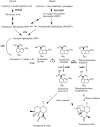Reproductive development modulates gene expression and metabolite levels with possible feedback inhibition of artemisinin in Artemisia annua
- PMID: 20724645
- PMCID: PMC2949044
- DOI: 10.1104/pp.110.162552
Reproductive development modulates gene expression and metabolite levels with possible feedback inhibition of artemisinin in Artemisia annua
Abstract
The relationship between the transition to budding and flowering in Artemisia annua and the production of the antimalarial sesquiterpene, artemisinin (AN), the dynamics of artemisinic metabolite changes, AN-related transcriptional changes, and plant and trichome developmental changes were measured. Maximum production of AN occurs during full flower stage within floral tissues, but that changes in the leafy bracts and nonbolt leaves as the plant shifts from budding to full flower. Expression levels of early pathway genes known to be involved in isopentenyl diphosphate and farnesyl diphosphate biosynthesis leading to AN were not immediately positively correlated with either AN or its precursors. However, we found that the later AN pathway genes, amorpha-4,11-diene synthase (ADS) and the cytochrome P450, CYP71AV1 (CYP), were more highly correlated with AN's immediate precursor, dihydroartemisinic acid, within all leaf tissues tested. In addition, leaf trichome formation throughout the developmental phases of the plant also appears to be more complex than originally thought. Trichome changes correlated closely with the levels of AN but not its precursors. Differences were observed in trichome densities that are dependent both on developmental stage (vegetative, budding, and flowering) and on position (upper and lower leaf tissue). AN levels declined significantly as plants matured, as did ADS and CYP transcripts. Spraying leaves with AN or artemisinic acid inhibited CYP transcription; artemisinic acid also inhibited ADS transcription. These data allow us to present a novel model for the differential control of AN biosynthesis as it relates to developmental stage and trichome maturation and collapse.
Figures







Similar articles
-
The effect of roots and media constituents on trichomes and artemisinin production in Artemisia annua L.Plant Cell Rep. 2013 Feb;32(2):207-18. doi: 10.1007/s00299-012-1355-4. Epub 2012 Oct 20. Plant Cell Rep. 2013. PMID: 23085820 Free PMC article.
-
TRICHOME AND ARTEMISININ REGULATOR 1 Is Required for Trichome Development and Artemisinin Biosynthesis in Artemisia annua.Mol Plant. 2015 Sep;8(9):1396-411. doi: 10.1016/j.molp.2015.04.002. Epub 2015 Apr 11. Mol Plant. 2015. PMID: 25870149
-
Trichome-specific expression of the amorpha-4,11-diene 12-hydroxylase (cyp71av1) gene, encoding a key enzyme of artemisinin biosynthesis in Artemisia annua, as reported by a promoter-GUS fusion.Plant Mol Biol. 2013 Jan;81(1-2):119-38. doi: 10.1007/s11103-012-9986-y. Epub 2012 Nov 19. Plant Mol Biol. 2013. PMID: 23161198
-
The biosynthesis of artemisinin (Qinghaosu) and the phytochemistry of Artemisia annua L. (Qinghao).Molecules. 2010 Oct 28;15(11):7603-98. doi: 10.3390/molecules15117603. Molecules. 2010. PMID: 21030913 Free PMC article. Review.
-
[Advances in molecular regulation of artemisinin biosynthesis].Sheng Wu Gong Cheng Xue Bao. 2003 Nov;19(6):646-50. Sheng Wu Gong Cheng Xue Bao. 2003. PMID: 15971573 Review. Chinese.
Cited by
-
Biosynthesis of sesquiterpene lactones in pyrethrum (Tanacetum cinerariifolium).PLoS One. 2013 May 31;8(5):e65030. doi: 10.1371/journal.pone.0065030. Print 2013. PLoS One. 2013. PMID: 23741445 Free PMC article.
-
Transgenic approach to increase artemisinin content in Artemisia annua L.Plant Cell Rep. 2014 Apr;33(4):605-15. doi: 10.1007/s00299-014-1566-y. Epub 2014 Jan 12. Plant Cell Rep. 2014. PMID: 24413765 Review.
-
Transcriptome repository of North-Western Himalayan endangered medicinal herbs: a paramount approach illuminating molecular perspective of phytoactive molecules and secondary metabolism.Mol Genet Genomics. 2021 Nov;296(6):1177-1202. doi: 10.1007/s00438-021-01821-x. Epub 2021 Sep 24. Mol Genet Genomics. 2021. PMID: 34557965 Review.
-
21st century natural product research and drug development and traditional medicines.Nat Prod Rep. 2013 Apr;30(4):584-92. doi: 10.1039/c3np20120a. Nat Prod Rep. 2013. PMID: 23450245 Free PMC article. Review.
-
Trichomes + roots + ROS = artemisinin: regulating artemisinin biosynthesis in Artemisia annua L.In Vitro Cell Dev Biol Plant. 2011 Jun;47(3):329-338. doi: 10.1007/s11627-011-9343-x. In Vitro Cell Dev Biol Plant. 2011. PMID: 21666770 Free PMC article.
References
-
- Acton N, Klayman DL. (1985) Artemisitene, a new sesquiterpene lactone endoperoxide from Artemisia annua. Planta Med 51: 441–442 - PubMed
-
- Bouwmeester HJ, Wallaart TE, Janssen MH, van Loo B, Jansen BJ, Posthumus MA, Schmidt CO, De Kraker JW, Konig WA, Franssen MC. (1999) Amorpha-4,11-diene synthase catalyses the first probable step in artemisinin biosynthesis. Phytochemistry 52: 843–854 - PubMed
Publication types
MeSH terms
Substances
Grants and funding
LinkOut - more resources
Full Text Sources

